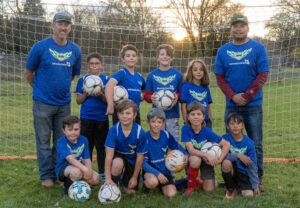The Power of Small-Sided Games: Building Skills and Confidence at MCSA
 At MCSA, we strive to challenge traditional norms of player development. Our player-centric approach often prompts questions from families in our Developmental Soccer League (DSL), such as, “Why are the youngest players playing 5v5 and the older kids only 7v7?” We also hear questions about why we aren’t pushing toward 11v11 at younger ages like traditional soccer formats. These are all valid questions, and we’d like to shed some light on the philosophy that guides our decisions.
At MCSA, we strive to challenge traditional norms of player development. Our player-centric approach often prompts questions from families in our Developmental Soccer League (DSL), such as, “Why are the youngest players playing 5v5 and the older kids only 7v7?” We also hear questions about why we aren’t pushing toward 11v11 at younger ages like traditional soccer formats. These are all valid questions, and we’d like to shed some light on the philosophy that guides our decisions.
A Player-Centric Approach
One of our core beliefs is that soccer is a team game — but only when kids are teenagers and adults. At younger ages, kids need to experience the game differently. A seven-year-old doesn’t want to pass the ball; they want to dribble, shoot, and score. When we ask very young players to play 7v7 or 11v11, we create an environment where some kids rarely touch the ball. This can quickly lead to frustration and a loss of interest. Our goal is to keep kids engaged and excited, allowing them to have fun while developing foundational skills.
We’ve adopted a small-sided approach, meaning younger players (U6 to U10) play in smaller formats, such as 3v3 or 5v5. This allows them more touches on the ball and greater opportunities to learn the game. We believe playing in smaller formats teaches kids how to control the ball, make quick decisions, and enjoy the game.
Learning from Global Best Practices
Around the world, leading soccer nations are adopting small-sided games for younger players. Belgium, for example, is renowned for its youth development program and emphasizes the importance of small-sided games. By allowing kids to play 3v3 and 5v5, they ensure that every player gets more touches on the ball, leading to better technical and tactical development.
MCSA’s approach mirrors that of these global soccer programs but is adapted to suit our players. For our U12 DSL teams, we play 7v7 instead of the US Club Soccer-mandated 9v9. We also use smaller fields to challenge our players to think quickly, be creative with the ball, and move effectively in tight spaces. These experiences prepare them for more traditional 11v11 formats as they grow older.
Small-Sided Games Build Technical Skills
Players have to think faster, move quicker, and engage in the game constantly. They can’t hide or take breaks, and they are involved in every moment of play. In small-sided games, all players become creators, goal-scorers, and defenders, giving them a well-rounded understanding of the game.
Technical proficiency, including ball control, dribbling, passing, and shooting, becomes the foundation for a player’s future success. These skills are honed more effectively in small-sided games because players are constantly interacting with the ball and making decisions. We emphasize the importance of a player’s first touch and decision-making, knowing that technical brilliance often trumps athleticism.
Teaching Movement and Tactics
In soccer, movement off the ball is as important as what a player does when they have the ball. Small-sided games encourage players to constantly move, providing support and creating space for their teammates. Whether it’s timing their runs, circulating around the ball, or creating a rhythm in play, small-sided games help players develop these critical skills.
Players who understand the importance of movement off the ball are better prepared to contribute to a team’s success. They learn how to create goal-scoring opportunities and play more attractive, fluid soccer. Our focus on small-sided games ensures players grasp these tactical elements at a young age.
A Pathway to Higher Levels of Play
Our DSL has become a key stepping stone for our select teams. Many players who began in DSL have advanced to MCSA’s record 19 select teams, which play at higher levels of competition. The small-sided games they experienced in DSL helped them develop the technical and tactical skills necessary to succeed at the next level.
We’re proud of the progress our players have made through this approach. By focusing on player development rather than team results at younger ages, we ensure that our players have the skills, confidence, and mindset to succeed on and off the field.
Conclusion
Our small-sided, player-centric approach is designed to create technically sound, creative, and confident players. By learning from global best practices and adapting them to our local context, we’re building a soccer program that meets the needs of every player. We believe that small-sided games are the best way to develop young players and prepare them for the challenges of full-sided soccer in the future.
Our DSL is more than just a league—it’s a foundation for long-term player development!
